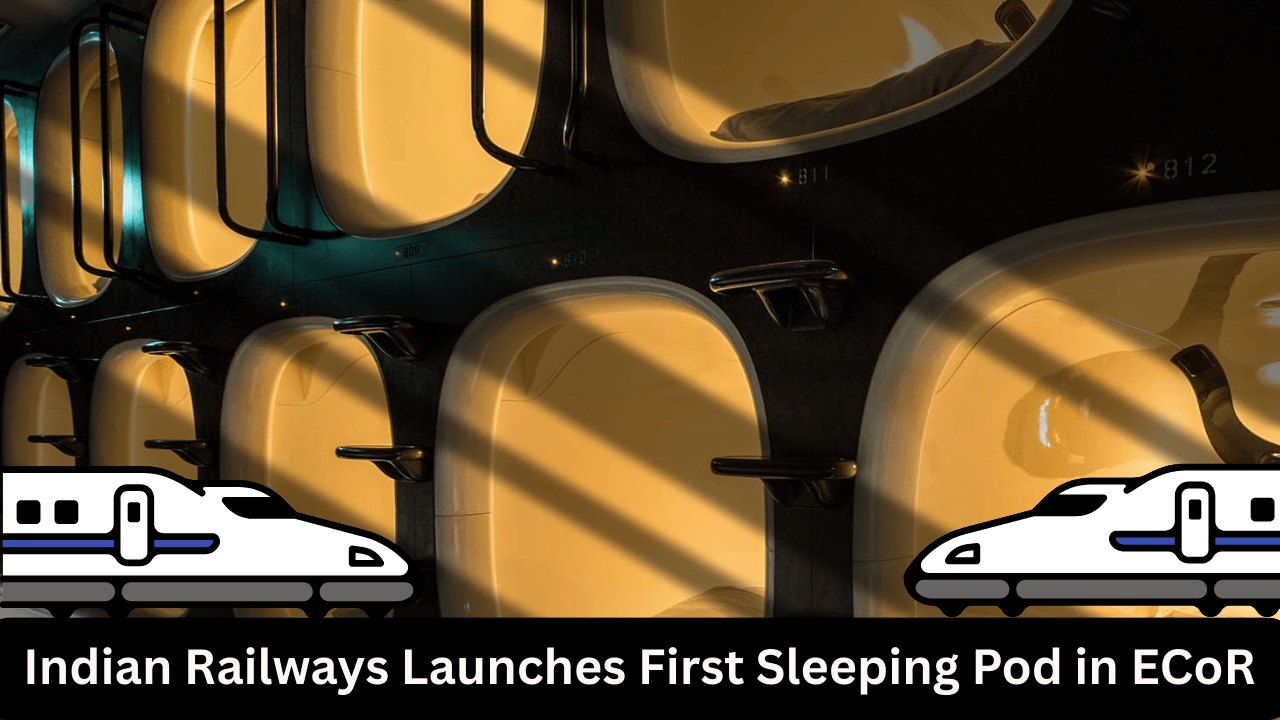Listen to This Article
🛌 First ‘Sleeping Pod’ Facility in East Coast Railway Zone: Comfort Meets Innovation in Indian Railways
Indian Railways has been rapidly modernizing to enhance passenger comfort and travel experience. Among its latest innovations is the introduction of the first ‘sleeping pod’ facility in the East Coast Railway zone, marking a huge leap forward in affordable short-stay solutions for travelers.
From tired passengers awaiting connecting trains to solo backpackers in need of privacy, these sleeping pods promise a clean, safe, and efficient alternative to traditional waiting rooms and hotels. Let’s dive into the details, pricing, and overall impact of this futuristic facility by Indian Railways.
🚆 What is a Sleeping Pod Facility?
🧳 A Modern Resting Space for Smart Travelers
A sleeping pod, also known as a capsule room, is a compact, self-contained resting unit equipped with essentials like a comfortable bed, charging ports, lighting, ventilation, and sometimes even a smart TV or mirror.
Inspired by Japan’s popular capsule hotels, these pods are designed for short-term use, making them ideal for passengers who are:
-
Waiting for a delayed train ⏳
-
In transit with a long layover 🧭
-
On business trips looking for privacy 👨💼
-
Traveling solo on a budget 🎒
With the launch of the first such facility in the East Coast Railway (ECoR) zone, Indian Railways has taken a big step toward modern, passenger-centric infrastructure.
🏙️ Where Is It Located?
The sleeping pod facility has been installed at Visakhapatnam Railway Station under the East Coast Railway zone. Known for its heavy passenger traffic and strategic importance in South India, Visakhapatnam was a natural choice for launching this pilot service.
🚉 Station Name: Visakhapatnam Junction (VSKP)
📍 Zone: East Coast Railway (ECoR)
🛠️ Operator: Indian Railways (in partnership with private agencies under PPP model)
🛏️ Key Features of the Sleeping Pod Facility
These pods are designed to maximize comfort in a compact space. Here's what you get:
🧼 1. Clean and Hygienic Interiors
The pods are sanitized regularly and come with fresh linens, pillow covers, and blankets.
🔌 2. Charging Ports & Reading Lights
Every pod includes USB charging outlets, reading lights, and power sockets.
🌬️ 3. Ventilation & Air Conditioning
Good airflow and temperature control make it comfortable even during summers.
🧠 4. Smart Facilities (In Select Pods)
Some premium pods come with entertainment systems, digital lockers, mirrors, and Wi-Fi.
🔒 5. Lockable & Private
Each pod can be locked from inside, offering privacy and security for solo travelers.
💸 Price: How Much Does It Cost?
One of the biggest advantages of these railway sleeping pods is affordability.
As per Indian Railways’ pricing model:
-
Basic Pod (Non-AC): ₹150 to ₹200 for 3 hours
-
Standard Pod (AC): ₹300 to ₹400 for 3 hours
-
Overnight Stay (8-12 hours): ₹600 to ₹999 depending on pod type
These prices may vary based on:
-
Duration of stay
-
Type of pod (basic, AC, premium)
-
Station category and demand
📌 Note: Bookings can be made online or at the station counter. Integration with IRCTC app is under progress.
 Unlock Your Savings Today!
Unlock Your Savings Today!
Get the best deals with unbeatable service and exclusive offers.

🛤️ Why This Move Matters for Indian Railways
🎯 Strategic Benefits
-
Passenger Comfort: Enhances the travel experience, especially during delays or long stopovers.
-
Space Optimization: Converts small areas into high-utility zones.
-
Revenue Generation: Operated on a PPP model, generating non-fare income for railways.
-
Brand Image: Aligns Indian Railways with international standards of hospitality.
📍 Future Expansion Plans
Following the success of sleeping pods at Mumbai Central and Bhopal, and now Visakhapatnam, Indian Railways plans to expand this model to:
-
Bhubaneswar
-
Secunderabad
-
Howrah
-
Ahmedabad
-
New Delhi
-
Chennai Central
Each of these high-footfall stations is expected to get 10–20 pods initially, with room for scaling.
🌐 Integration with Smart India Vision
The sleeping pod initiative is part of the broader Digital India and Smart Station vision led by the Ministry of Railways. It integrates:
-
Cashless payments
-
Automated booking kiosks
-
Real-time availability display systems
-
QR code entry system
This supports Indian Railways' goal to not just move people, but to also deliver comfort, safety, and convenience in line with global trends.
🧳 Who Should Use Sleeping Pods?
These pods are ideal for:
-
Business travelers on short trips
-
Students and solo backpackers
-
Families waiting for connecting trains
-
Pilgrims and festival attendees
-
Tourists avoiding high hotel charges
If you're ever passing through Visakhapatnam or another future pod-enabled station, these pods can save you money and give you rest in peace — literally!
⚖️ Pros and Cons of Sleeping Pods
✅ Advantages:
-
🔐 Privacy and safety
-
💰 Budget-friendly pricing
-
🧼 Clean and hygienic environment
-
🔌 Power access and amenities
-
🕒 Available for short durations (3–12 hours)
❌ Disadvantages:
-
📏 Limited space; not ideal for claustrophobic individuals
-
🧍♂️ Not suitable for families or groups
-
💺 No attached bathrooms (common washrooms used)
-
📶 Wi-Fi may not be strong or consistent in all locations
📝 Final Thoughts: A Modern Step by Indian Railways
With the introduction of the first sleeping pod in East Coast Railway, Indian Railways is once again proving its commitment to modernization and passenger-centric service.
As more stations adopt this model, travelers across the country can expect affordable, comfortable, and safe resting options, especially during uncertain delays and long transit times.
If Indian Railways continues this momentum, soon sleeping pods may become a standard offering at all major stations—redefining what it means to travel by train in India. 🚆💼
 Grow Your Business with Proven Digital Marketing
Grow Your Business with Proven Digital Marketing
Ready to attract more customers and outshine your competition? Our tailored digital marketing strategies help you rank higher, generate qualified leads, and build a brand people trust. Let’s take your business to the next level.
Digital Marketing Solutions in Leading Cities

✅ Advantages of Indian Railways' Sleeping Pod Facility 🛌🚆
🔐 1. Enhanced Privacy & Safety
Sleeping pods offer a secure, lockable space for solo travelers.
🛡️ Perfect for women, business travelers, and solo tourists.
💸 2. Affordable Alternative to Hotels
With prices starting as low as ₹150 for 3 hours, it’s ideal for short rest breaks without spending on expensive hotel rooms.
💰 Great value for money.
🧼 3. Clean, Hygienic Environment
Regular sanitation and clean bedding ensure a hygienic resting experience.
🧽 A much better option than crowded waiting rooms.
🔌 4. Smart Amenities in Compact Spaces
Charging ports, reading lights, ventilation, and even entertainment options in premium pods.
📱 Designed for modern travelers.
📍 5. Convenient Location Inside Stations
No need to leave the station area – the pods are usually within walking distance of platforms.
🚉 Quick rest before your next train.
⚠️ Disadvantages of the Sleeping Pod Facility 😴🚫
📏 1. Very Limited Space
Pods are compact and not suitable for those uncomfortable in tight spaces.
😖 Not ideal for claustrophobic passengers.
🧍 2. Not Suitable for Families or Groups
These are solo units, so families or multiple passengers cannot share a pod.
👨👩👦 Group travelers need alternate options.
🚻 3. No Attached Bathroom
Pods don’t have en-suite washrooms; you must use the station’s public toilets.
🚽 May be inconvenient for some travelers.
📶 4. Inconsistent Wi-Fi or Connectivity
Wi-Fi may not be available or strong in all stations or pods.
📡 Could be a drawback for digital nomads or business travelers.
🛏️ 5. Limited Number of Pods
Initial installations have a small number of pods, and they may get fully booked quickly during peak hours.
📆 Advance booking is recommended.
📝 Final Verdict:
The sleeping pod is an innovative step by Indian Railways toward providing affordable and private rest spaces at busy stations. While it’s not a one-size-fits-all solution, it offers huge value for the right kind of traveler – especially those in transit for short durations.

 Disclaimer
Disclaimer
The views expressed by experts in this article are their own and do not necessarily reflect the opinions of any website, organization, institution, or affiliated entity. If you have any concerns regarding this article, please contact us at contact@quantamminds.com and also on WhatsApp
Frequently Asked Questions
What is a sleeping pod in Indian Railways?
A sleeping pod is a compact, self-contained capsule room designed for passengers to rest comfortably at railway stations. It includes features like a bed, charging ports, lighting, ventilation, and privacy — offering a budget-friendly and secure alternative to hotels or waiting halls.
Where is the first sleeping pod facility in the East Coast Railway zone located?
The first sleeping pod facility in the East Coast Railway zone has been set up at Visakhapatnam Railway Station. It's a pilot project aimed at improving short-term accommodation options for passengers in transit.
How much does it cost to use a sleeping pod at a railway station?
Prices for sleeping pods range from ₹150 to ₹400 for 3 hours, depending on the type (AC or non-AC). Longer stays (up to 12 hours) may cost ₹600 to ₹999. It's a cost-effective solution for short-term rest.
Are these sleeping pods safe for solo female travelers?
Yes, sleeping pods are lockable from inside and are located within secure station premises. Many of them are also monitored by CCTV and maintained under railway-authorized service providers, ensuring safety and privacy for all users, including solo female travelers.
Can I book sleeping pods online or through IRCTC?
Currently, bookings can be made at the station or via the operator’s kiosk. Indian Railways is working to integrate sleeping pod bookings with the IRCTC app and website soon for easier access and planning.








 Ashwani Kumar on 2025-07-11
Ashwani Kumar on 2025-07-11

 Pallavi Singh
Pallavi Singh 



